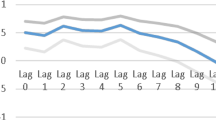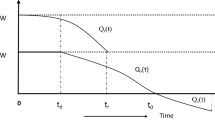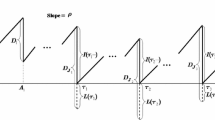Abstract
Inventory problems with incomplete inventory information arise frequently in practice because demand or invisible demand is not observed directly but both reduce the inventory level. In this paper, we develop a periodic-review lost-sales inventory model, where the sales is always observed while the inventory level is observed only when it reaches zero. Our objective is to minimize the expected discounted cost over an infinite horizon, and we use dynamic programming along with the concept of unnormalized probability to solve the problem. The interaction between the sales and zero-balance walk signal simplifies the updating process of the inventory level distribution. Interestingly, the evolution of inventory distribution is independent of the demand. We also find a mean-based approximation has the customary dynamic program of the completely observed problem giving rise to a lower bound on the optimal cost of the original problem. Furthermore, incorporating the variance of inventory level improves the bound.

Similar content being viewed by others
References
Aviv Y, Pazgal A (2005) A partially observed Markov decision process for dynamic pricing. Manage Sci 51(9):1400–1416
Bassamboo A, Moreno A, Stamatopoulos I (2020) Inventory auditing and replenishment using point-of-sales data. Prod Oper Manag 29(5):1219–1231
Bensoussan A, Cakanyildirim M, Li M, Sethi SP (2016) Managing inventory with cash register information: sales recorded but not demands. Prod Oper Manag 25(1):9–21
Bensoussan A, Çakanyildirim M, Sethi SP (2007) Partially observed inventory systems: the case of zero-balance walk. SIAM J Control Optim 46(1):176–209
Camdereli AZ, Swaminathan JM (2010) Misplaced inventory and radio-frequency identification (RFID) technology: information and coordination. Prod Oper Manag 19(1):1–18
Chen L (2021) Fixing phantom stockouts: optimal data-driven shelf inspection policies. Prod Oper Manag 30(3):689–702
Chen Li, Mersereau Adam J (2015) Analytics for operational visibility in the retail store: the cases of censored demand and inventory record inaccuracy. Retail supply chain management. Springer, Cham, pp 79–112
DeHoratius N, Mersereau AJ, Schrage L (2008) Retail inventory management when records are inaccurate. Manuf Serv Oper Manag 10(2):257–277
DeHoratius N, Raman A (2008) Inventory record inaccuracy: an empirical analysis. Manage Sci 54(4):627–641
Fisher ML, Raman A, McClelland AS (2000) Rocket science retailing is almost here-are you ready? Harv Bus Rev 78(4):115–123
Heese HS (2007) Inventory record inaccuracy, double marginalization, and RFID adoption. Prod Oper Manag 16(5):542–553
Kök AG, Shang KH (2007) Inspection and replenishment policies for systems with inventory record inaccuracy. Manuf Serv Oper Manag 9(2):185–205
Lee H, Özer Ö (2007) Unlocking the value of RFID. Prod Oper Manag 16(1):40–64
Lovejoy WS (1991) Computationally feasible bounds for partially observed Markov decision processes. Oper Res 39(1):162–175
Mersereau AJ (2013) Information-sensitive replenishment when inventory records are inaccurate. Prod Oper Manag 22(4):792–810
Mersereau AJ (2015) Demand estimation from censored observations with inventory record inaccuracy. Manuf Serv Oper Manag 17(3):335–349
Nurani RK, Sridhar Seshadri J, Shanthikumar G (1997) Optimal control of a single stage production system subject to random process shifts. Oper Res 45(5):713–724
Papadimitriou CH, Tsitsiklis JN (1987) The complexity of Markov decision processes. Math Oper Res 12(3):441–450
Raman A, DeHoratius N, Ton Z (2001) Execution: the missing link in retail operations. Calif Manage Rev 43(3):136–152
Rieder U (1991) Structural results for partially observed control models. Z Oper Res 35(6):473–490
Ton Z, Raman A (2010) The effect of product variety and inventory levels on retail store sales: a longitudinal study. Prod Oper Manag 19(5):546–560
Author information
Authors and Affiliations
Corresponding author
Additional information
Publisher's Note
Springer Nature remains neutral with regard to jurisdictional claims in published maps and institutional affiliations.
Supplementary Information
Below is the link to the electronic supplementary material.
Rights and permissions
Springer Nature or its licensor (e.g. a society or other partner) holds exclusive rights to this article under a publishing agreement with the author(s) or other rightsholder(s); author self-archiving of the accepted manuscript version of this article is solely governed by the terms of such publishing agreement and applicable law.
About this article
Cite this article
Bensoussan, A., Çakanyıldırım, M., Li, M. et al. Inventory model with incomplete information: sales and zero-balance signals. Cent Eur J Oper Res 33, 571–584 (2025). https://doi.org/10.1007/s10100-025-00979-8
Accepted:
Published:
Issue Date:
DOI: https://doi.org/10.1007/s10100-025-00979-8




